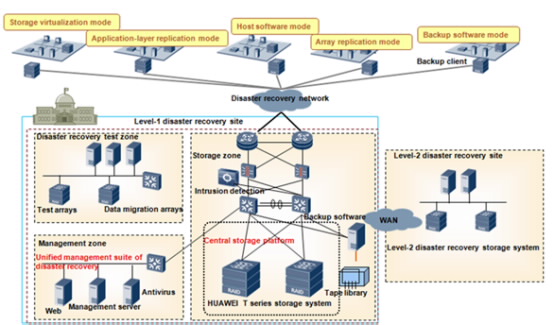As information technology (IT) develops rapidly, information systems play an increasing important role in managing critical services of various industries. The centralized service processing generates large amounts of data. Those mission-critical data are generally stored on the servers and storage systems of an organization's individual sectors. Any data damage, due to fires, earthquakes, theft, viruses, or misoperations, can bring about catastrophic losses to the organization. This challenge demands a highly reliable disaster recovery system.
In general, disaster recovery systems are complex and expensive. Disaster recovery systems deployed for each individual department are costly and hard to maintain. Therefore, organizations tend to construct shared disaster recovery systems to simplify deployment and reduce costs.
Shared disaster recovery systems enable resource sharing among departments and simplify system deployment. Based on the previous experience, the following problems exist in the construction of shared disaster recovery systems:
- Enterprises are inexperienced and unfamiliar with disaster recovery construction. Their management methods, technologies, and operation and maintenance (O&M) are out of date. No construction standard can be learned from. Investment protection and long-term planning cannot be balanced.
- The construction of shared disaster recovery platforms requires cross-department system deployment. Management and maintenance are complicated and the OM cost is high. Rights and responsibilities among departments and disaster recovery centers are unclear. This causes unnecessary disputes in the running of systems. Therefore, unified management is required for disaster recovery systems.
- Disaster recovery platforms provide services to multiple departments. The main difficulty lies in the inconsistency of departments' IT system construction, complicated data storage modes, and different requirements for disaster recovery. Disaster recovery centers cannot meet enterprises' different and complicated requirements. Disaster recovery is not a unified and optional service to departments. These problems are difficult to handle.
- The disaster recovery center cannot recover data in a timely manner and start services quickly when natural disasters or human misoperations cause system breakdowns and data damage.
Huawei provides a shared disaster recovery solution to resolve the previous problems and help enterprises construct shared disaster recovery platforms at affordable cost.
Enterprises can deploy one Huawei storage system in every department and one or more Huawei mid-range and high-end storage systems in shared disaster recovery centers to lower the total cost of ownership (TCO). Various technologies are applied to replicate data from departments to Huawei storage systems. Huawei diversified replication functions further back up the replicated data in level-1 and level-2 disaster recovery sites.

Advanced disaster recovery management
Huawei storage systems provide end-to-end process management during the construction of shared disaster recovery systems. The management platform locates at the level-1 disaster recovery site to manage departments' service processes such as requests, approvals, implementations, modifications, and cancellations. It also manages permissions between disaster recovery centers and enterprise departments.
The solution provides software and hardware interfaces open to third-party management systems and delivers customizable services to meet different enterprises' requirements.
Diversified data backup modes
The solution provides various modes to back up data from departments into Huawei storage systems and satisfy complicated disaster recovery requirements of departments.
- For UNIX applications, Huawei virtualized gateway products simultaneously mirror data to Huawei storage systems.
- For cluster applications, the application-layer replication technology can periodically replicate data from local disks arrays to Huawei storage systems.
- For stand-alone applications, Huawei host protection technology periodically replicates data from local disks or other disk arrays to Huawei storage systems.
- For disaster recovery systems that have adopted Huawei storage systems, HyperMirror technology can replicate data to disaster recovery centers.
- For departments having backup requirements, the backup software can replicate data to disaster recovery centers.
The solution adopts the many-to-one technology of Huawei storage systems and enables multiple departments to simultaneously replicate data to one disaster recovery center. Huawei storage systems support a maximum of 32 sites to replicate data to the same disaster recovery center.
The solution provides a multilevel disaster recovery solution to meet customers' different requirements and ensure data security to the greatest extent. Huawei's HyperMirror/A technology supports cascaded replication to meet requirements of multisite disaster recovery.
High availability of data in the disaster recovery center
The solution supports disaster recovery tests to verify data availability in the disaster recovery system and checks the integrity and consistency of backup data at the snapshot points in time. The solution provides fast and reliable disaster recovery switchovers to resolve system breakdowns and data damage caused by natural disasters or human disoperation and ensure that the disaster recovery center recovers data timely and takes over services quickly.
Comprehensive design
The solution uses multiple technologies and gives full consideration to enterprises' existing conditions. The whole disaster recovery system has a comprehensive design and a multilevel management mode that covers the entire disaster recovery process.
Architecture of flexible scalability
The solution meets the requirements of all government departments for disaster recovery. Its architecture has flexible scalability. The disaster recovery center adopts a virtualized gateway to construct a virtualized storage resource pool and increases the system capacity to PB-level. Access points of departments increase with the expansion of the virtualized-gateway cluster. The storage pool of a disaster recovery center can be expanded smoothly at a later time. The unified management of heterogeneous arrays enables the construction of a unified storage pool. The expansion of the whole system is easy to achieve.
High reliability
Key links and devices in a disaster recovery system are fully redundant to ensure that single points of failure have no influence on the running of the whole disaster recovery system. The solution provides solid protection to the disaster recovery center, and ensures the reliable running of every area in the center.
Convenient management and maintenance, clear responsibilities
The management of the whole system adopts advanced disaster recovery management software to implement permission-specific management. Disaster recovery centers and departments have specific responsibilities and strict hierarchical systems to enable the continuous running of the whole disaster recovery system.

